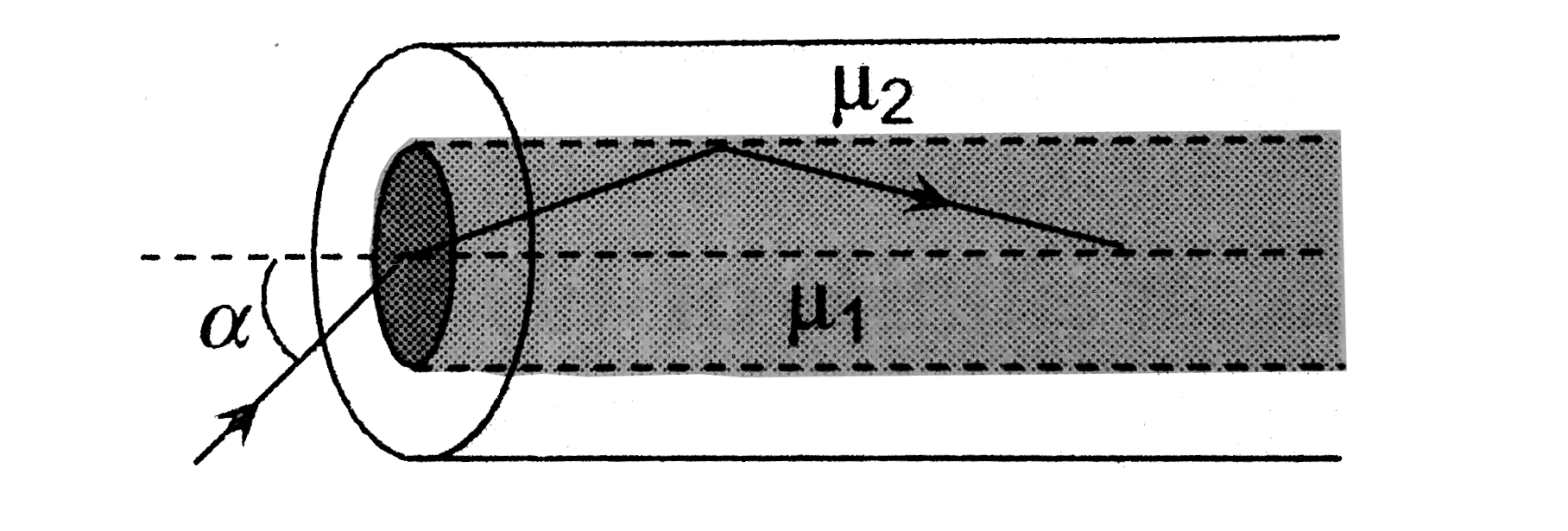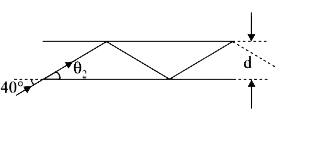An optical fiber consists of core of μ1 surrounded by a cladding of μ2<μ1. A beam of light enters from air at an angle α with axis of fiber. The highest α for which ray can be travelled through fiber is

cos−1√μ22−μ21
sin−1√μ21−μ22
tan−1√μ21−μ22
sec−1√μ21−μ22
The correct Answer is:B
Here the requirement is that i>c
⇒sini>sinc⇒sini>μ2μ1 ...(i)
From Snell's law μ1=sinαsinr ...(ii)
Also in ΔOBA
r+i=90∘⇒r=(90−i)
Hence from equation (ii)
sinα=μ1sin(90−i)
⇒cosi=sinαμ1
sini=√1−cos2i=√1(sinαμ1)2
From equations (i) and (iii) √1−(sinαμ1)2>μ2μ1
⇒sin2α<(μ21−μ22)⇒sinα<√μ21−μ22
αmax=sin−1√μ21−μ22

Topper's Solved these Questions
- BOOK - A2ZCHAPTER - GEOMETRICAL OPTICSEXERCISE - Assertion Reason15videos
GEOMETRICAL OPTICS
- BOOK - A2ZCHAPTER - GEOMETRICAL OPTICSEXERCISE - Section D - Chapter End Test30videos
GEOMETRICAL OPTICS
- BOOK - A2ZCHAPTER - GEOMETRICAL OPTICSEXERCISE - Section B - Assertion Reasoning19videos
GEOMETRICAL OPTICS
- BOOK - A2ZCHAPTER - ELECTROMAGNETIC WAVES AND COMMUNICATION SYSTEM EXERCISE - Section D - Chapter End Test30videos
ELECTROMAGNETIC WAVES AND COMMUNICATION SYSTEM
- BOOK - A2ZCHAPTER - MAGNETISM AND MATTEREXERCISE - Section D - Chapter End Test30videos
MAGNETISM AND MATTER
Similar Questions
Total internal reflection of light ray from cylindrical optical fiber
An optical fiber consists of a cylindrical core of unknown refractive index kept in air. A ray of light is incident on the flat face of the core so that it gets totally reflected at the curved surface (Fig.34-19). What is the possible refractive index if the ray is totally reflected at any angle of incidence ϕ from air ?View SolutionIn figure, the optical fiber is l = 2 m long and has a diameter of d=20μm. If a ray of light is incident on one end of the fiber at angle θ1=40∘ , the number of reflections it makes before emerging form the other end is close to : (refractive index of fiber is 1.31 and sin40∘=0.64)
 View Solution
View Solution
Knowledge Check
- Question 1 - Select One
An optical fibre consists of core of μ1 surrounded by a cladding of μ2<μ1 . A beam of light enters from air at an angle α with axis of fibre. The highest α for which ray can be travelled through fibre is
 Acos−1√μ22−μ21Bsin−1√μ21−μ22Ctan−1√μ21−μ22Dsec−1√μ21−μ22
Acos−1√μ22−μ21Bsin−1√μ21−μ22Ctan−1√μ21−μ22Dsec−1√μ21−μ22 - Question 2 - Select One
An optical fiber consists of core of μ1 surrounded by a cladding of μ2<μ1. A beam of light enters from air at an angle α with axis of fiber. The highest α for which ray can be travelled through fiber is
 Acos−1√μ22−μ21Bsin−1√μ21−μ22Ctan−1√μ21−μ22Dsec−1√μ21−μ22
Acos−1√μ22−μ21Bsin−1√μ21−μ22Ctan−1√μ21−μ22Dsec−1√μ21−μ22 - Question 3 - Select One
A concave lens having a material of refractive index μ1 is kept in a medium of R.I. μ2, where μ1<μ2. A parallel beam of light is incident on the lens. The concave lens will act as
Aa diverging lensBa converging lensCa plane glass slabDa plano concave lens
An optical fibre has diameter d and is made of material of refractive indeed μ. It is surrounded by air. Light is made to enter through one end of the fibre as shown. The fiber is in the shape of a circular bend of outer radius r.
(a) Find least value of r(=ro) for which no light can escape out of the fibre. Calculate ro for d=200μm and μ=1.4.
(b) How is value of ro affected as d is made smaller?
(c) For sharper bends, shall we have higher μ or smaller μ ?
 View Solution
View SolutionThere are two blocks of masses m1 and m2,m1 is placed on m2 on a table which is rotating with an angular velocity ω about the vertical axis . The coefficent of friction between the block is μ1 and between m2 and table is μ2(μ1<μ2) if block are placed at distance R from the axis of ratation , for relative sliding between the surface in contact , find the
a. friction force at the contacting surface
b. maximum angular speed ω
 View Solution
View SolutionOptical Fibre:
Optical fibre works on the principle of total internal reflection. Light rays can be used to transmit a huge amount of data, but there is a problem here - the light rays travel in straight lines. So unless we have a long straight wire without any bends at all, harnessing this advantage will be very tedious. Instead, the optical cables are designed such that they bend all the light rays' inwards (using TIR). Light rays travel continuously, bouncing off the optical fibre walls and transmitting end to end data. It is usually made of plastic or glass.
Modes of transmission: Single-mode fibre is used for long-distance transmission, while multi mode fiber is used for shorter distances. The outer cladding of these fibres needs better protection than metal wires. Although light signals do degrade over progressing distances due to absorption and scattering. Then, optical Regenerator system is necessary to boost the signal.
Types of Optical Fibres: The types of optical fibers depend on the refractive index, materials used, and mode of propagation of light. The classification based on the refractive index is as follows:
• Step Index Fibres: It consists of a core surrounded by the cladding, which has a single uniform index of refraction.
• Graded Index Fibres: The refractive index of the optical fibre decreases as the radial distance from the fibre axis increases.
Light signal through optical fibre may degrade due to:View SolutionOptical Fibre:
Optical fibre works on the principle of total internal reflection. Light rays can be used to transmit a huge amount of data, but there is a problem here - the light rays travel in straight lines. So unless we have a long straight wire without any bends at all, harnessing this advantage will be very tedious. Instead, the optical cables are designed such that they bend all the light rays' inwards (using TIR). Light rays travel continuously, bouncing off the optical fibre walls and transmitting end to end data. It is usually made of plastic or glass.
Modes of transmission: Single-mode fibre is used for long-distance transmission, while multi mode fiber is used for shorter distances. The outer cladding of these fibres needs better protection than metal wires. Although light signals do degrade over progressing distances due to absorption and scattering. Then, optical Regenerator system is necessary to boost the signal.
Types of Optical Fibres: The types of optical fibers depend on the refractive index, materials used, and mode of propagation of light. The classification based on the refractive index is as follows:
• Step Index Fibres: It consists of a core surrounded by the cladding, which has a single uniform index of refraction.
• Graded Index Fibres: The refractive index of the optical fibre decreases as the radial distance from the fibre axis increases.
Optical fibre works on the principle of:View SolutionOptical Fibre:
Optical fibre works on the principle of total internal reflection. Light rays can be used to transmit a huge amount of data, but there is a problem here - the light rays travel in straight lines. So unless we have a long straight wire without any bends at all, harnessing this advantage will be very tedious. Instead, the optical cables are designed such that they bend all the light rays' inwards (using TIR). Light rays travel continuously, bouncing off the optical fibre walls and transmitting end to end data. It is usually made of plastic or glass.
Modes of transmission: Single-mode fibre is used for long-distance transmission, while multi mode fiber is used for shorter distances. The outer cladding of these fibres needs better protection than metal wires. Although light signals do degrade over progressing distances due to absorption and scattering. Then, optical Regenerator system is necessary to boost the signal.
Types of Optical Fibres: The types of optical fibers depend on the refractive index, materials used, and mode of propagation of light. The classification based on the refractive index is as follows:
• Step Index Fibres: It consists of a core surrounded by the cladding, which has a single uniform index of refraction.
• Graded Index Fibres: The refractive index of the optical fibre decreases as the radial distance from the fibre axis increases.
In graded index optical fibre:View Solution

